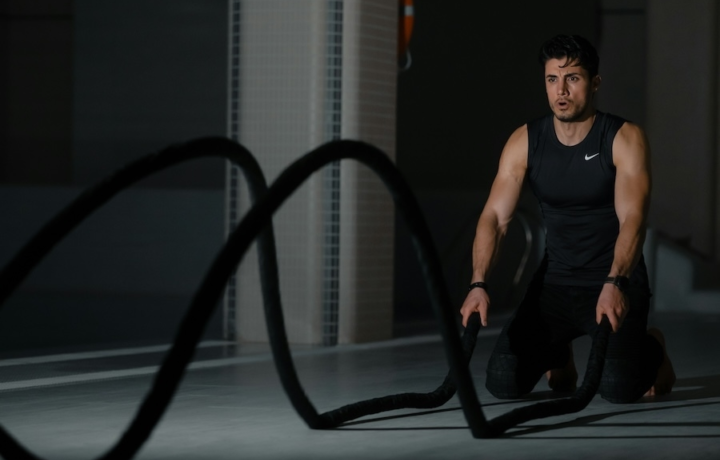Exercise
Dumbbell Thruster

Dumbbell Thruster
How to Perform
- Stand with feet shoulder-width apart and hold a dumbbell in each hand at shoulder height, with elbows bent and palms facing inward.
- Position the dumbbells so they rest on the front of your shoulders with elbows pointing down and slightly forward, maintaining a neutral spine.
- Brace your core and inhale as you begin to lower into a squat position, keeping your chest up and back straight.
- Descend until your thighs are at least parallel to the ground, ensuring your knees track over your toes and heels remain planted.
- Drive through your heels and exhale as you explosively stand up, keeping the dumbbells at shoulder level during the initial phase of the movement.
- As you reach the top of the standing position, press the dumbbells overhead in one fluid motion, fully extending your arms.
- Lock out your elbows at the top with arms alongside your ears, ensuring your shoulders remain down away from your ears.
- Slowly lower the dumbbells back to shoulder position as you prepare for the next repetition.
Important information
- Keep your core engaged throughout the entire movement to protect your lower back, especially during the transition from squat to press.
- Avoid letting your knees collapse inward during the squat portion; actively push them outward in line with your toes.
- If you experience shoulder discomfort, try using a neutral grip (palms facing each other) during the overhead press portion.
- Start with lighter weights to master the coordination of this compound movement before progressing to heavier loads.

Dumbbell Thruster
Exercise Details
Primary Muscles
Muscle Groups
Mechanic
Risk Areas
Built for progress
Take the guesswork out of training
Create personalized AI-powered workout plans that evolve with you. Train smarter, track every rep and keep moving forward, one workout at a time.






The Dumbbell Thruster combines a front squat and overhead press into one fluid, compound movement that delivers an impressive full-body workout in minimal time. This intermediate-level exercise predominantly targets your quads, pecs, and front deltoids while engaging numerous secondary muscle groups throughout your entire body.
Popular in HIIT, CrossFit, and bodybuilding circles, the Dumbbell Thruster has earned its reputation as a metabolic powerhouse. The movement's seamless transition from lower to upper body work creates a cardiovascular demand that can rapidly elevate your heart rate while building both strength and endurance simultaneously. This dual benefit makes it particularly valuable for athletes looking to maximize their training efficiency.
What sets the Dumbbell Thruster apart is its remarkable versatility. Whether you're looking to build explosive power, increase muscular endurance, or simply burn calories, this exercise delivers results. The movement pattern also translates directly to everyday functional activities, improving your ability to lift objects from low positions and press them overhead – a practical benefit beyond aesthetic improvements.
For those new to thrusters, starting with lighter dumbbells allows you to master the movement pattern before progressing to challenging weights. The exercise's scalability makes it suitable for various fitness levels despite its intermediate classification. Many athletes incorporate thrusters into circuit training or as a standalone movement when seeking an efficient total-body stimulus.
The Dumbbell Thruster's effectiveness comes from its compound nature – you're essentially performing two exercises in one motion. This efficiency makes it particularly valuable for time-constrained workouts, allowing you to challenge multiple major muscle groups while developing coordination between your upper and lower body. The cardiovascular demand creates a conditioning effect that continues well after your workout concludes.
Whether you're seeking to build functional strength, enhance athletic performance, or simply achieve a more efficient workout, the Dumbbell Thruster deserves consideration in your exercise repertoire. Its ability to simultaneously challenge multiple fitness components – strength, power, endurance, and coordination – makes it a truly exceptional exercise choice.
FAQ - Dumbbell Thruster
Dumbbell Thrusters primarily target your quadriceps, shoulders (deltoids), and chest (pectorals). They also engage your core, glutes, hamstrings, and triceps as secondary muscle groups, making it a true full-body compound exercise.
Beginners should start with lighter weights (5-10 lbs) and focus on mastering the movement pattern before increasing load. For a more challenging version, use heavier dumbbells, increase repetitions, or incorporate thrusters into HIIT circuits with minimal rest periods.
The most common mistakes include not squatting deep enough, letting your elbows drop during the front rack position, and using momentum rather than controlled strength to press overhead. Always maintain a neutral spine, keep your chest up during the squat, and fully extend your arms at the top of the movement.
Include Dumbbell Thrusters 1-3 times per week with at least 48 hours between sessions to allow for adequate recovery. They work well as part of full-body workouts, upper/lower splits, or as a metabolic finisher at the end of your routine.
Those with existing shoulder or knee conditions should approach thrusters with caution. Consider working with lighter weights, limiting range of motion (partial squats), or consulting with a physical therapist for modifications. The exercise can be beneficial when performed correctly, but form is critical to prevent exacerbating existing issues.









